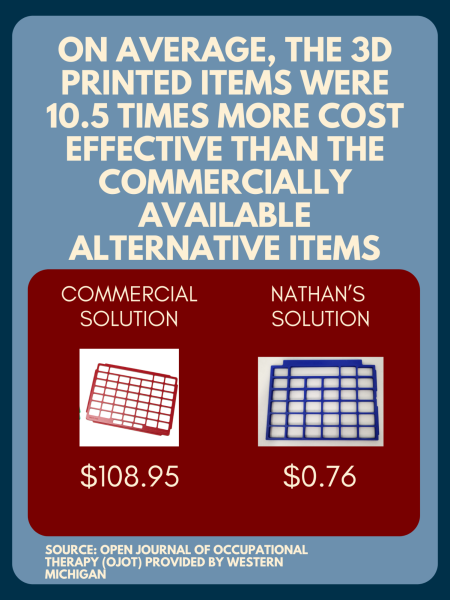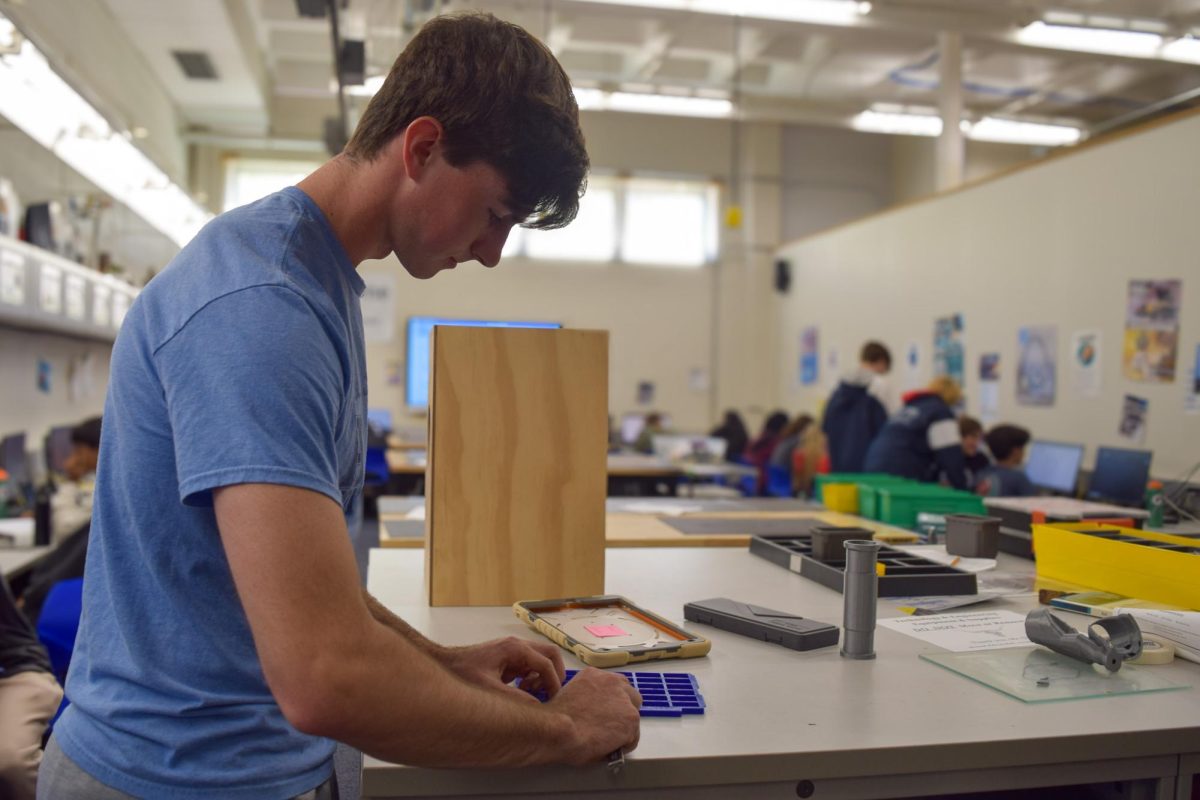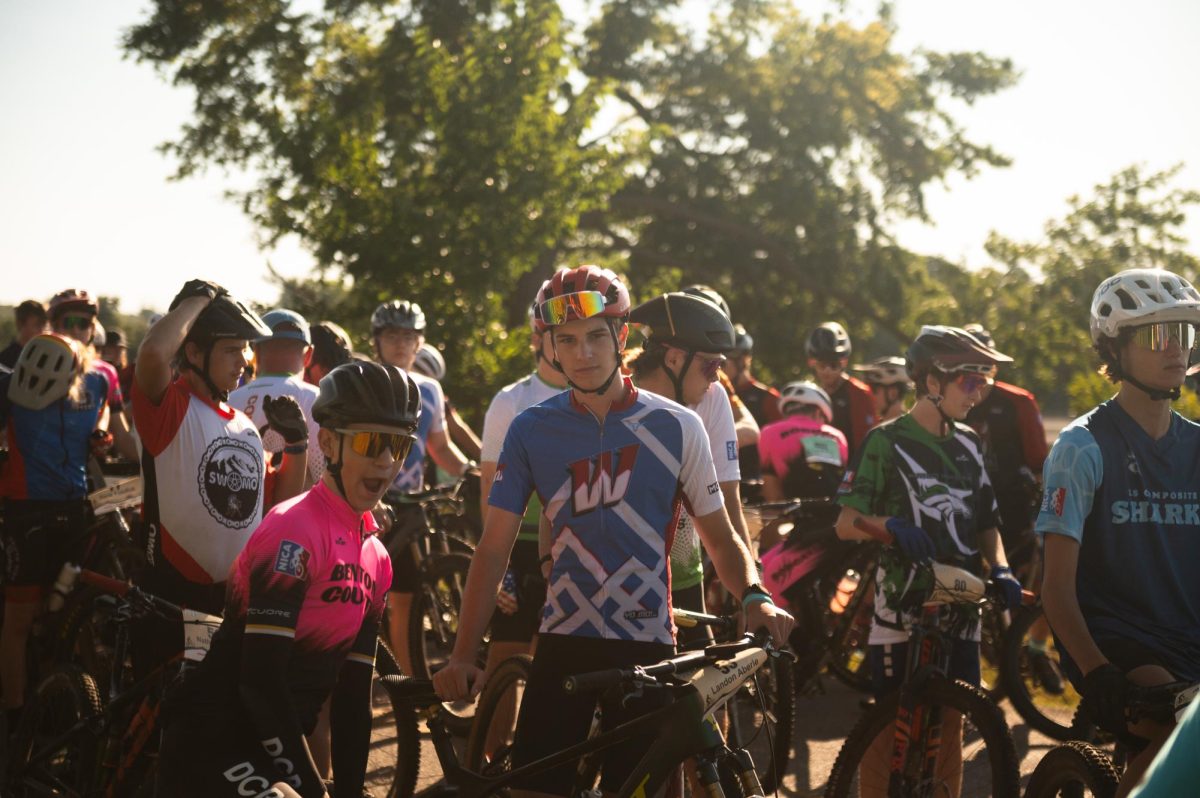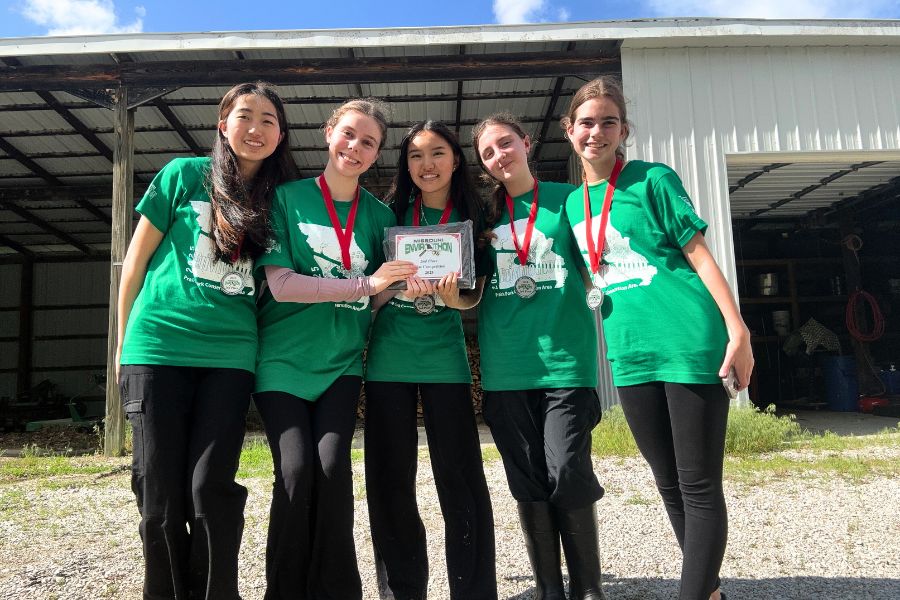As problem-solvers, engineers often design solutions to help improve people’s quality of life; in fact, the device you are using right now to read this article was designed by an engineer with these same goals. Ultimately, engineers create solutions to everyday problems.
Similarly, assistive devices, also known as adaptive devices, improve the quality of life for people who struggle with a variety of disabilities, such as deafness and dyspraxia. The need for assistive devices has risen to 2.5 billion people globally, showing how important this technology is, especially for a growing population. With the rise in need for these devices comes a necessity to use engineering-specific thinking to combat associated issues that come with using an assistive device.
At West High, students have the ability to choose from seven engineering courses, offering diversity in coursework and opportunities to jump into the world of engineering innovation— taking on unique projects to learn about different principles of engineering. Project Lead the Way (PLTW), the provider of engineering courses for the Parkway school district, implements an emphasis on problem-solving, encouraging students to explore and think for themselves.
Senior Nathan Thompson has taken nearly every PLTW engineering course offered by West. In his junior year, he decided to be a cadet teacher for engineering teacher Chris Donaldson. Afterward, Donaldson and Thompson collaborated on creating an independent studies curriculum focused on prototyping, 3D modeling and manufacturing for Thompson’s senior year schedule.
“I’ve taken a majority of Donaldson’s classes and they follow the same structure, so I was looking for something different where I had more creative freedom. [In my independent study], I’m currently designing a coffee table for myself,” Thompson said.
Due to his expertise from taking Donaldson’s classes since freshman year, and his involvement with the independent study creative curriculum, Thompson was the first candidate for a unique project proposed by the special education department at the Webster Groves school district in October.

“A special education teacher reached out to me and was wondering if a student could pick up this opportunity. She needed an [assistive] device to aid a student that struggled with their motor skills. The first person who I knew could solve this problem was [Thompson], so I proposed it to him,” Donaldson said.
The Webster student facing the disability issue uses an augmentative alternative communication (AAC) app, which allows them to communicate by touching a button. The technology produces a word or sentence so the student can communicate with others verbally, if they happen to be nonverbal.
“While there were products on the market that would assist the student with pressing the buttons, they were too thin to meet this student’s needs. They’re called keyguards and they can be really expensive, which is a problem because the cost of these devices makes doing certain [activities] inaccessible, especially when the price can take away clear communication,” Donaldson said.
At West High, students have the ability to choose from seven engineering courses, offering diversity in coursework and opportunities to jump into the world of engineering innovation— taking on unique projects to learn about different principles of engineering. Project Lead the Way (PLTW), the provider of engineering courses for the Parkway school district, implements an emphasis on problem-solving, encouraging students to explore and think for themselves.
Senior Nathan Thompson has taken nearly every PLTW engineering course offered by West. In his junior year, he decided to be a cadet teacher for engineering teacher Chris Donaldson. Afterward, Donaldson and Thompson collaborated on creating an independent studies curriculum focused on prototyping, 3D modeling and manufacturing for Thompson’s senior year schedule.
“I’ve taken a majority of Donaldson’s classes and they follow the same structure, so I was looking for something different where I had more creative freedom. [In my independent study], I’m currently designing a coffee table for myself,” Thompson said.
Due to his expertise from taking Donaldson’s classes since freshman year, and his involvement with the independent study creative curriculum, Thompson was the first candidate for a unique project proposed by the special education department at the Webster Groves school district in October.
“A special education teacher reached out to me and was wondering if a student could pick up this opportunity. She needed an [assistive] device to aid a student that struggled with their motor skills. The first person who I knew could solve this problem was [Thompson], so I proposed it to him,” Donaldson said.
The Webster student facing the disability issue uses an augmentative alternative communication (AAC) app, which allows them to communicate by touching a button. The technology produces a word or sentence so the student can communicate with others verbally, if they happen to be nonverbal.
“While there were products on the market that would assist the student with pressing the buttons, they were too thin to meet this student’s needs. They’re called keyguards and they can be really expensive, which is a problem because the cost of these devices makes doing certain [activities] inaccessible, especially when the price can take away clear communication,” Donaldson said.
Keyguards separate the keys or buttons on a device, making it easier for people who struggle with motor skills to push individual buttons. This allows for the student to communicate clearly, letting the student’s conversations with others to be concise. However, for students with motor skill issues who don’t have a keyguard, or a keyguard that doesn’t meet the student’s needs, it means that their conversations with others can be convoluted or misinterpreted.
“Mr. Donaldson asked me if I wanted to pick up a project and I agreed to do it, so I got to work. I drove up to Webster Groves to speak with the student and their teachers. What was happening was that it was hard for the kid to push down buttons on their iPad because all of their fingers would press down on multiple buttons,” Thompson said.
Working back and forth with the Webster Groves student, Thompson eventually developed prototypes using computer-aided design (CAD) software to make a 3D printed model. The final product was based on the iPad case’s dimensions, perfectly fitting the device onto the screen. The device divided up the digital buttons, making it easier for the student to press each individual button.
“It was a [very] tedious, long process, especially with the communication back and forth. It took a month and a half [because] I was doing it alone. [If I had to] work with other people, it would have [taken] maybe a week,” Thompson said.
Although the process took a long time, Thompson found it valuable to help others with his engineering skills. The keyguard was then sent to the student, after which they could clearly communicate with the people in their life.
“[The device] helps for the student to communicate because he can’t speak. With this, the student is able to rest his palm on top of the keyguard and use his fingers to hit the buttons under it. So, if he wants food or [to go to] the bathroom or anything, he has a way to communicate with his parents or anyone around him,” Thompson said.
In the future, Thompson hopes to continue positively impacting the lives of others around him and plans to major in industrial engineering at the University of Missouri, Columbia to grow his engineering skills.
“This project really showed me how engineering can be applied to real life issues. I’m glad that I could make [a] change in someone else’s life, which was a unique experience that I got from this project,” Thompson said.




![Gazing across the stage, sophomore Alexis Monteleone performs in the school theater. The Monteleone family’s band “Monte and the Machine” has been releasing music since 2012, but Alexis started her own solo career in 2024 with the release of her first single, Crying Skies. “My whole family is very musical, [and I especially] love writing [songs with them],” Monteleone said.](https://pwestpathfinder.com/wp-content/uploads/2025/09/DSC7463-1200x798.jpg)
![Amid teaching a lesson to her AP Calculus BC class, Kristin Judd jokes alongside her students in their funny remarks. Judd has always enjoyed keeping the mood light in her classroom, along with on the volleyball court. “[I enjoy] that side talk where you see [or] overhear a conversation and chime in, or somebody says something funny,” Judd said.](https://pwestpathfinder.com/wp-content/uploads/2025/09/image-1200x730.jpg)
![Eyeing the ball, junior Ella McNeal poses for her commitment pictures at Clemson University. McNeal’s commitment comes after months of contact with top Division 1 soccer programs. “ It has taken a lot to get to where I am, but I know that [what] I've already been through is just the beginning, and I can't wait for what is to come,” McNeal said.](https://pwestpathfinder.com/wp-content/uploads/2025/09/IMG_4926-1200x900.jpeg)


![Senior Adam Zerega stands with senior Dexter Brooks by farm equipment. Zerega often worked with friends and family on his farm. “I've been able to go to my family's farm since I was born. I [spend] at least three weekends a month [on the farm], so I'm there all the time,” Zerega said.](https://pwestpathfinder.com/wp-content/uploads/2025/04/IMG_4872-1200x900.jpg)
![Phage grown by senior Rio Naghibi Harat sit in petri dishes. Through Webster University, Naghibi Harat was given the opportunity to develop phage as a potential remedy for tuberculosis. “Phage are everywhere. I got mine from a soil sample. I'm not kidding; I picked [it] up from dirt. They're harmless, unless you code them to do something, and they can evolve. Virus antibiotics can't. They're one solid molecule. A strain of this bacteria [can evolve] that is resistant to [a] particular drug, [but] phage will evolve with the bacteria. They can see the changes, and they can be the change,” Naghibi Harat said.](https://pwestpathfinder.com/wp-content/uploads/2025/04/Flag-2.png)
![Hosting a meeting for Women’s History Month, co-president Bethany Liao converses with club members of Women in Healthcare. The event fostered discussions about women in medicine and included a third year medical student from Bosnia as a guest speaker. “Creating this club has been a net positive experience for everyone. After we present [or a guest speaker], we [also] usually have snacks for everyone and it gives people an opportunity to generally talk or discuss,” Liao said.](https://pwestpathfinder.com/wp-content/uploads/2025/04/DSC0032-1-1200x800.jpg)


Yusra • May 13, 2025 at 7:52 am
great work writing this Opal!!